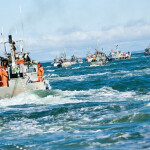A new quota and licensing system in Victoria, Australia, for the commercial sea urchin fishery is expected to boost exports of the valuable seafood.
The new system, mandated by the government in August, aims to grow overseas markets and provide commercial fishermen with “greater security and confidence to invest in their businesses and develop local and overseas markets,” according to Fisheries Victoria Executive Director Ross McGowan. Victoria sea urchin is not currently exported.
"The sea urchin fishery is a high-value niche fishery with the potential to grow as local consumer and export markets become aware of the quality product Victoria has to offer. The edible part of the sea urchin, the urchin roe, is a highly prized delicacy in overseas markets, particularly in Japan," McGowan said in a statement.
The value of the Victorian sea urchin catch in 2012 was estimated at AUD 648,000 (USD 558,802; EUR 449,667), and the fishery brought in 62.8 tons of whole urchin.
The new system “will ensure long-term sustainability, economic efficiency and cost effective management of the fishery,” a spokesperson for Victoria’s Department of Environment and Primary Industries, told SeafoodSource. “By securing long-term fishing rights, the industry will now be able to invest in growing markets to supply local and overseas markets with this increasingly sought after delicacy.”
The sea urchin fishery has been operating as a “developing fishery” since 1998 under short-term permits. The new fishery will be managed under a conservative Total Allowable Commercial Catch (TACC) and divers will only be allowed to collect sea urchin by hand, according to the spokesperson.
The TACC will initially be set at 60 tons of white urchin for Port Phillip Bay, 57 tons of white urchin for Eastern Zone and 114 tons of black urchin for Eastern Zone. “Further growth of this fishery in other areas of Victoria will be considered over time,” the spokesperson said.
Harvesters will report their catch volumes via a purpose-designed smartphone app, to help with monitoring of catch to ensure sustainability and cost effective enforcement.
“This easy-to-use technology has been developed to reduce paper-based reporting requirements and provide cost effective fisheries enforcement, thereby reducing cost to industry,” the spokesperson said.






